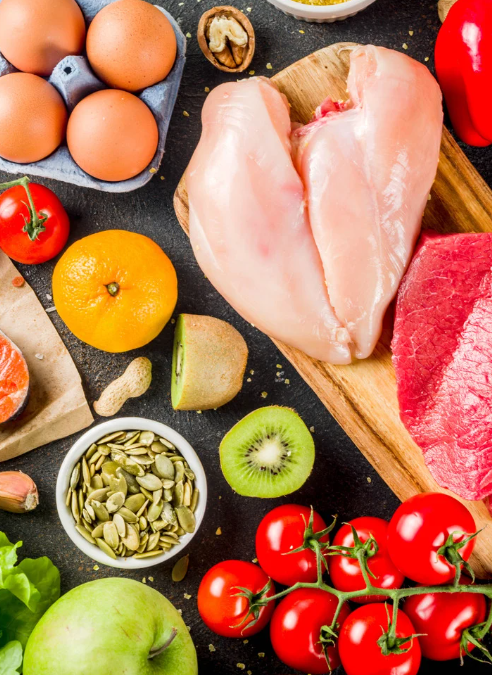Talking about diet & nutrition can be a tough topic for some, but it’s an incredibly important conversation to have, especially in the context of recovery & performance. While dietary needs will vary from person to person, there are some essentials that should not be skipped in the pursuit of optimal recovery from the strain of exercise and even daily life.
Calorie intake is always a hot-button issue, but at the end of the day, calorie consumption is nothing more than a balanced or unbalanced math equation. When we lay down for bed each day, three possible scenarios have happened:
1. We’ve consumed the exact same amount of energy through food that we’ve used for energy throughout our day. We call this amount our maintenance intake.
2. We’ve consumed more energy through food than we’ve used for energy throughout our day. We call this amount a surplus. You may have heard of the term “bulking” to describe intentionally overeating in order to gain weight, specifically muscle mass
3. We’ve consumed less energy through food than we’ve used for energy throughout our day. We call this amount a deficit. You may have heard of the term “cutting” to describe unintentionally undereating in order to lose weight, specifically, fat mass
Finding these amounts can be important depending on your goal, and takes some old-fashioned “guess & check” work. We always recommend working with a skilled nutrition coach or dietitian. You can also ask your physical therapist about different methods, apps, and other systems to try to better understand how much food you’re consuming and how much energy you’re using on a daily basis.
What’s ideal? This will vary from person to person based on exercise history, muscle mass, fat mass, bone density, and a number of other variables. That being said, science is learning more & more about ideal ranges for calorie intake. This systematic review with meta-analysis looked at 39 separate research papers studying approximately 2,000 patients with and without eating disorders. The sum of this data is very helpful as it tells us very few adults without an eating disorder are eating less than 1400-1700 calories per day. If you’re looking to lose weight, it’s important to know that you do not need to undereat as much as you may think!
On the other side of the spectrum, very few adults without an eating disorder consume more than 4,500 calories per day. Highly active individuals performing long, heavy manual labor or several sessions of exercise may need to consume 3,000 – 4,000 calories a day to support themselves, but very few people on the planet need to eat 5,000 or more calories per day to maintain or gain weight.
While we cannot know your ideal calorie intake without beginning to track input (food) and output (movement), we can give some recommendations that every person can benefit from:
1. Most human beings should be eating approximately 1 gram (1g) of protein per pound of ideal body weight. For example, a 180# individual who is active almost every day with a structured exercise program should aim to consume 180 grams of protein each day. This is enough protein to support the body in its daily processes plus extra to help heal & grow muscle damaged. Some may find that they need slightly more protein each day. Extreme muscle soreness, fatigue, and decreased performance with physical activity & exercise are all hallmark symptoms of underfueling, especially of protein. While regular exercise will make you slightly fatigued & sore, it should not be debilitating. Consider increasing your protein intake & monitoring your symptoms.
Is that safe? A large systematic review with meta-analysis evaluated 25 research papers across 41 years and 1,300 stud subjects & found no increased risk of kidney damage with increased protein intake at or above 100 grams/day.
2. If you are feeling run down on a regular basis, and especially if you notice beginning to have trouble falling asleep, or staying asleep, or begin to develop night sweats, you are experiencing classic signs of overtraining & underfueling. Consider adding 100 calories more per day of food & monitoring how you feel.
3. Support your exercise & day-to-day activities by aiming to drink half your body weight (measured in pounds) in liquid per day (measured in ounces). For example, a 200 lb. person should aim to drink at least 100 oz. of fluid per day. Some will argue that only 100% pure water counts as hydration for your body, but your kidneys would disagree 😀 While it does take some additional time, your body is able to use the water found in drinks like tea or coffee for hydration. If you believe you are drinking enough fluid but still feel thirsty, especially after exercise, you may need to supplement with a salt-based drink like LMNT or Liquid IV. While too much sodium can cause issues with blood pressure, individuals who exercise regularly have nothing to worry about. We can lose 7-10 grams of sodium per day through sweat, and replenishing that can improve how we feel and may be what you need to finally feel your thirst quenched
If you’re near Fenton, MI, and want more help with performance tips like these, give us an email at info@healthhq.fit, or call/text at 810-354-5380. Our entire staff of physical therapists enjoy living an active lifestyle and want to help you live one as well!

